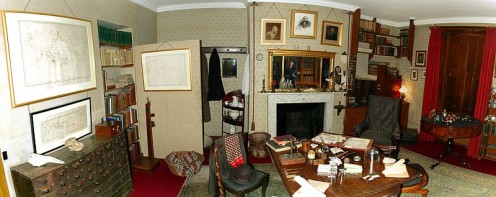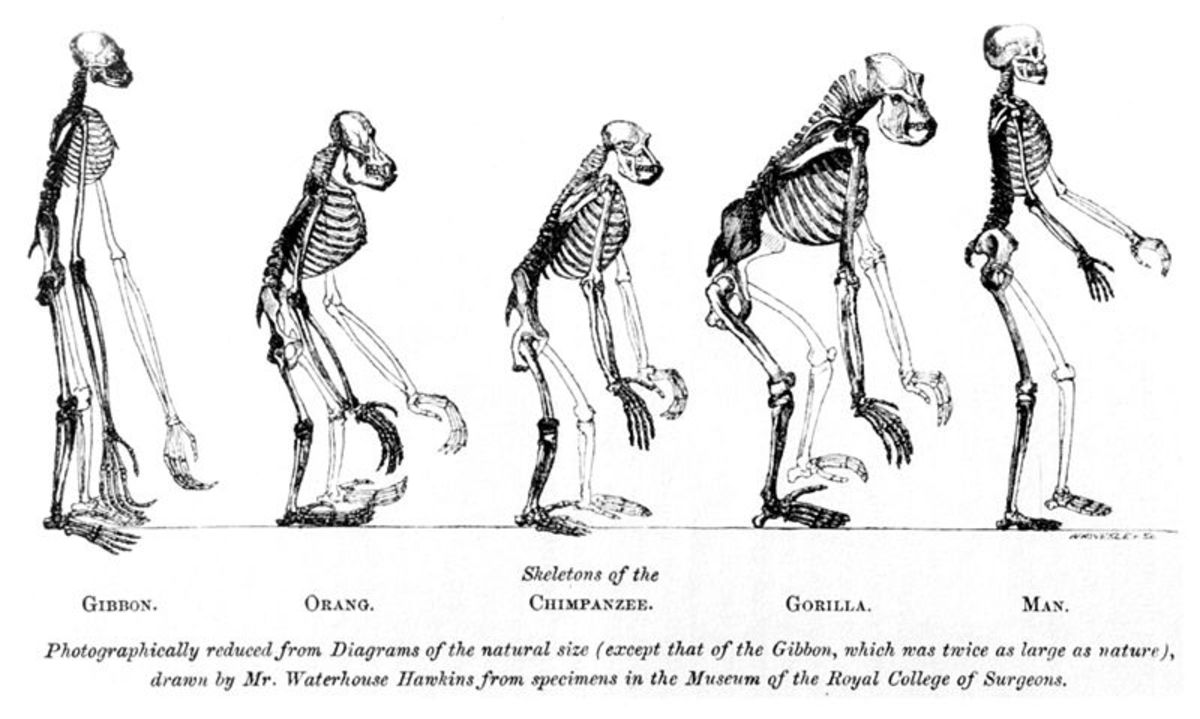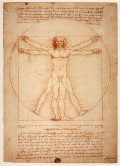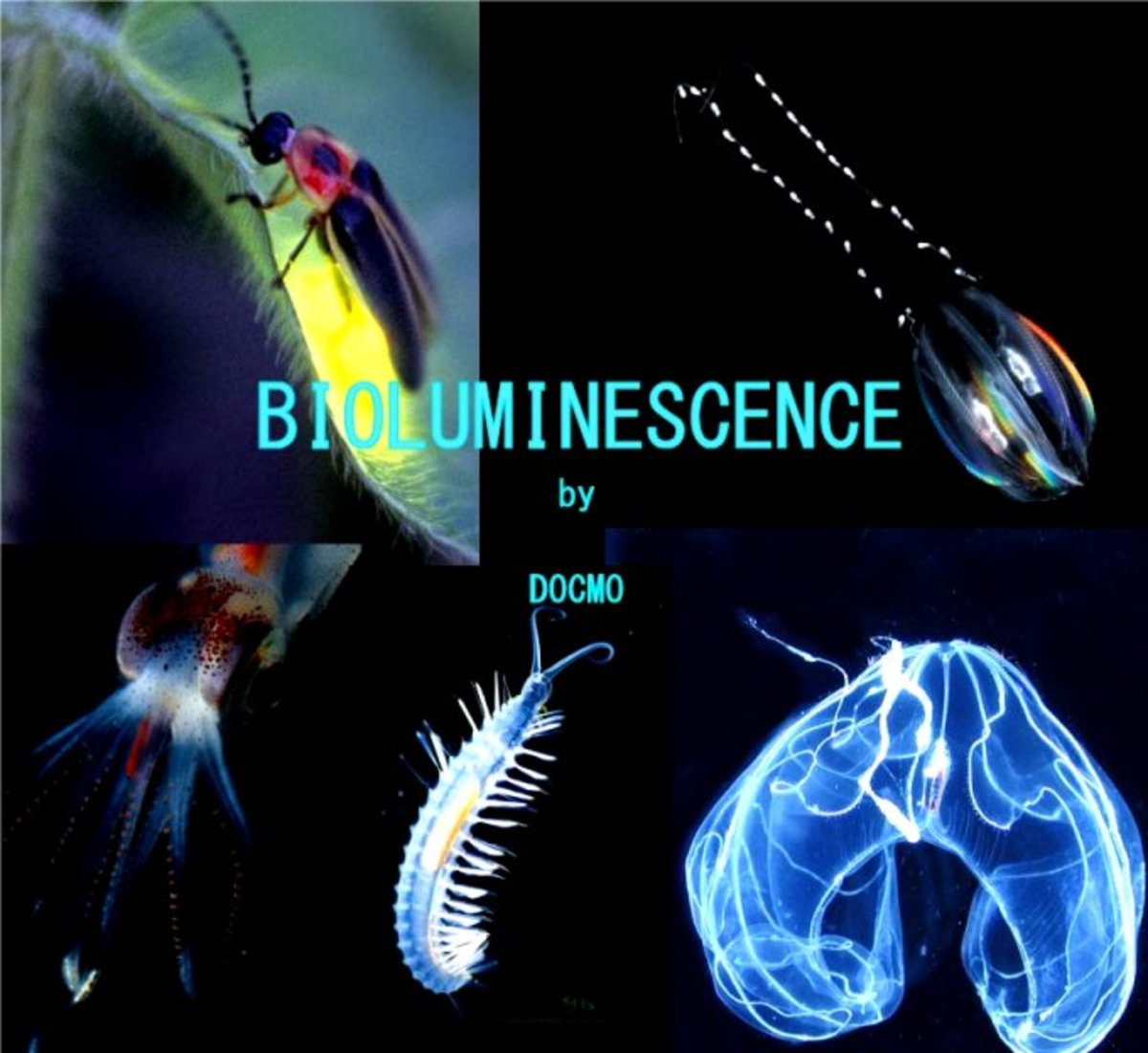R-Evolutionary Thinker Charles Darwin
Charles Robert Darwin (born February 12, 1809 in Shrewsbury in Shropshire in England , died April 19, 1882 Down in Kent , England) was a British naturalist . He is best known for having founded the modern theory of evolution but also contributed a number of other works in systematics , ecology and paleontology .
Darwin's contributions to biology can hardly be overestimated. Evolutionary doctrine gave systematics a theoretical foundation, and made it possible for the first time a scientific theory of animal and plant adaptations and their incredible biodiversity . Today, learning about Darwin's natural selection, is a basic foundation for all biological research, and used in finding new application areas, including in medicine and nutrition .
The book The Origin of Species , published in 1859 , is regarded as his magnum opus. The book explains very thoroughly natural selection with countless examples. When it came it caused great debate and heated controversy, but Darwin was recognized in his own lifetime as the greatest British natural scientist, and of comparable importance to men like Sir Isaac Newton, next to whom he was buried at the end of his life.
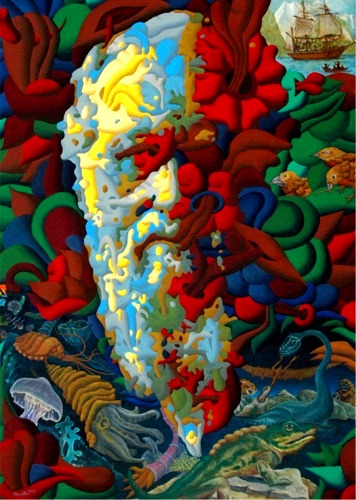
Charles Darwin Early Life
His mother died when Darwin was only eight years old, and he spent time and effort to follow his father's medical practice in the area. His father Robert Darwin was not only a successful physician, he was also a keen Freemason and a convinced atheist.
16 years old Darwin began to study medicine in Edinburgh (1825-1927), but did poorly in his studies. In particular, the lectures in anatomy (which included dissection of corpses in the early morning hours) and the brutal surgical methods at the time (this was before the anesthesia had been used), he had no stomach for.. Anatomy lessons he described later in his memoirs as a nightmare. He participated with zeal, however in the Plinian Society, and studied life on the shore of the Firth of Forth .
In 1827 Robert Darwin had had enough of his son's lack of progress in his studies and got him enrolled at Christ's College in Cambridge . There, he was studying for a bachelor's in philosophy , which would qualify him to the Anglican ministry. Darwin was not particularly keen theologian, and found the lectures uninspiring and boring. A keen naturalist philosopher by the name Robert Grant had a certain kind of influence on him, Grant was a freethinker who held the physical and chemical forces to be the driving force for life's origins and development.
As often as he could Darwin took time off from theology to breed pigeons and hunt. He was interested in nature and outdoor activities, and next to the studies he read what was then called natural philosophy (ie, biology and geology ) on his own, followed the lectures and participated in field trips. Biology and geology, it was that occupied him most during these years of study. He was thrilled by the work of scientists William Whewell , Adam Sedgwick and John Stevens Henslowe .
Robert Darwin complained that his son had become an "idle young scamp with no other interest than sports and hunting."
In 1831, Darwin finally took a theology exam with good grades. His philosophy of life at that time has been characterized as a "relaxed Protestantism," which managed to go hand in hand with a clear materialistic tendency.
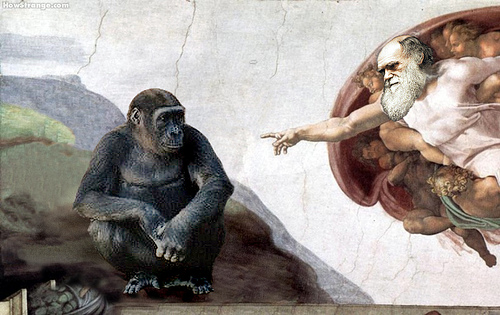
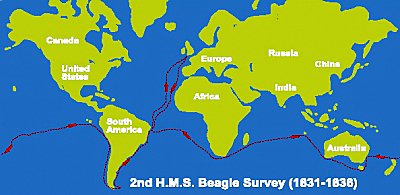
Normally, a young man in Darwin's situation got a small priesthood in the countryside, where he could live the rest of his life in relative peace and quiet, holding devotions on weekends and otherwise enjoy their natural interest. Natural science was then in its infancy, and was considered a part of theology (as "natural philosophy"). Quite a few priests were interested in natural philosophy, and published scientific articles in spare time.
The contacts and knowledge and interests of Darwin led to meeting the priest and botanist John Stevens Henslowe who recommended him as an honorary gentleman companion to the young marine captain and naturalist Robert FitzRoy in his planned circumnavigation of HMS Beagle " . Senior Darwin was skeptical of his son to take up at what he saw as yet another insecure enterprise. Darwin complained to his uncle, china manufacturer Josiah Wedgwood II , who persuaded his father to let the young Darwin set out on his great adventure.
In The Voyage of the Beagle, Charles Darwin explicated his theory of how coral atolls come about. His theory is the now the widely accepted idea.
In the ocean, a volcano issues up out of the sea. It grows upward by depositing lava layer on top of layer. Shortly, living organisms (including coral) start living round the shores of the new out-cropping. The volcano gets dormant, and begins to gradually sink (higher land has a tendency to sink).
As the island descends, old coral perishes. Some because it is now in a watery environment that is too deep. However, new coral grows on top of the now aged, dead coral. Subsequently the island now has a ring of coral circling it. A lagoon intercepts the island from its ring of coral. Less hardy species of coral also exist in the lagoon, protected by the tougher coral at the edge.
In time, the island submerges under the sea. The ring of coral is all that is left, with a small lagoon in the middle. The island has now become a coral atoll.
The Creation of a Coral Atoll according to Darwin
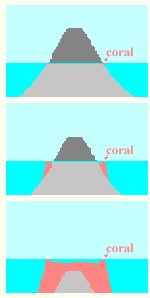
Darwin received advice from Henslowe to read the first volume of the Principles of Geology by Charles Lyell. Lyell was a gradualist, and described the continents and landscape formations as the result of the same processes as are operating on earth today, gradual processes over time.
On the first trip ashore at St Jago Darwin found that a white layer high in the volcanic cliffs consisted of baked coral fragments and shells.
This gave proof to Lyell's theory that the land rose or fell slowly, giving Darwin a new insight into the geological history of the island and put him on to the idea of writing a book on geology. He went on to make more discoveries, some of them very dramatic.
He found rocks and shells from the sea in Patagonia that gave evidence that beaches had risen, and after an earthquake in Chile he saw clam fields stranded above high water mark, proof that the country had risen.
High in the Andes, he observed several fossil trees that had grown on a sandy beach and nearby shellfish from the sea. He developed the theory that coral atolls were on sinking volcanic mountains, and had strengthened the theory when the "Beagle" examined the Cocos Islands .
In South America Darwin dug out rare fossils of extinct large mammals and identified an individual correctly as a Megatherium (an extinct group dinosaur) and bits of shell that resembled a local species of armadillos and made the assumption that the findings were related to African or European species.
He explained later to Richard Owen that they were closely related to species that exist only on the American continent.
Evolution
"It is interesting to contemplate an entangled bank, clothed with many plants of many kinds, with birds singing on the bushes, with various insects flitting about, and with worms crawling through the damp earth, and to reflect that these elaborately constructed forms, so different from "It is interesting to contemplate an entangled bank, cloth"It is interesting to contemplate an entangled bank, clothed with many plants of many kinds, with birds singing on the bushes, with various insects flitting about, and with worms crawling through the damp earth, and to reflect that these elaborately constructed forms, so different from each other, and dependent on each other in so complex a manner, have all been produced by laws acting around us." - Charles Darwin (1859)
In 1831 he joined, as a naturalist, the crew of the British Navy ship HMS Beagle, which would conduct a mapping expedition around the world for 5 years.
This trip was essential to the thinking of Charles Darwin. In the Galapagos Islands in the Pacific Ocean off South America, Darwin was impressed by the species of animals he saw and, above all, by the sometimes subtle differences between birds of the islands.
From these observations, Darwin realized that these differences could be connected with the fact that the species lived in a different environment with different sources of food. At that time Darwin first began to formulate his revolutionary ideas about how life evolves, as opposed to being 'created'.
Darwin understood that any population of individuals is slightly different one from another.
Variations between individuals means each one has different abilities to adapt to the environment, successfully reproduce and pass on their traits to their offspring.
Over generations, the traits of individuals best adapted to natural conditions become more common and the population evolves. Darwin called this process "descent with modification." Similarly, nature selects the species best adapted to survive and reproduce. This process is called natural selection.
Darwin's thinking was also strongly influenced by the ideas of Thomas Malthus, who wrote that the human population tended to grow exponentially and so to finish the food resources available. This causes a crisis that leads individuals to compete against each other for survival. Darwin believed that variations in heritable traits of individuals made them more or less able to face competition for resources.
More than 20 years after he began to develop his ideas about evolution, Darwin published his theory in his book The Origin of Species (1859). Its publication caused great controversy and is opposed by religious thinkers because he dismissed the creationist theory or 'creationist belief'. This book convinced scientists and the educated public that living things change over time.
The Origin of Species (1859)
The Origin of Species (1859)
The theory of evolution that Darwin had postulated resulted in an a great impact on the course of European thought in the second half of the nineteenth century. The main arguments of the Origin of Species, published in 1859 are:
1. The biological types or species are not fixed or static but are constantly changing (or 'evolving').
2. Life is manifested as a constant struggle for existence and survival.
3. The struggle for survival means that organisms that are less suited to a specific environment disappear which allows the best adapted to reproduce, this process is called natural selection. "
4. Natural selection, development and evolution requires an enormous amount of time, in most cases, and hence are not subject to direct observation during the span of a human lifetime.
5. The genetic variations that lead to increasing probability of survival are not random and not caused by God nor are they the result of the tendency for organisms to seek perfection (as proposed by Lamarck).
The importance of Charles Darwin's revolutionary work and thought was widely recognized by the intellectual community of his peers.
Darwin was elected a Fellow of the Royal Society (1839) and the French Academy of Sciences (1878). After his death in Down, England, on April 19, 1882 Darwin was paid the honor of being buried in Westminster Abbey.
Down House Study of Charles Darwin
